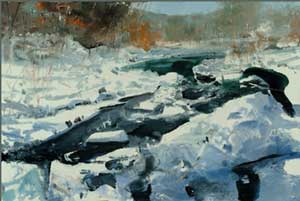
Ice Jumble 2008 oil on linen 30 x 36 inches
Larry Groff:
I read online that you said that, “Painting in a landscape relies on stories, the history of people, places and other paintings as much as it relies on interesting and compelling forms and light. It has to do with mixing observation and study with discovery and imagination.”
Can you speak more about these thoughts? Actually, you just did, in many ways, but I’m particularly interested in the relying on stories part. That seems a part of your paintings as well, from what I’ve seen.
Eric Aho:
I remember saying something like that in relation to a group of paintings that followed one of my Fellowship Projects in Scandinavia.
LG:
I believe that was it, yes.
Eric Aho:
In the case of this project that I’m talking about, it was a historical path of both the glacial retreat, and how that created the landscape in Finland and Northern Scandinavia, as well as the history of World War II, where the occupying German forces retreated from Finland and engaged in what was called a scorched-earth policy.
They burned everything in front of them, and destroyed not only the towns, but also the harvestable, usable and beautiful landscape in front of them. They created a vast swath that coincidentally followed much the same path as the glacial drag. So there are two compounding histories: one natural and one human; both destructive but both regenerative, as well, or subsequently regenerative.
I guess I’ve always been interested in the narrative potential for painting. I’m much more interested in that than I am in spectacle, which is the art of just throwing the paint around and saying, “Well, here it is.” I’m much more interested in accomplishing something that has the weight of some human experience: whether it’s mine, just by sitting there on a hillside, observing and thinking about things such as that, or occasionally I get to encounter a farmer who has an anecdote or two about the land that he works on every day. I’ve often joked with some of these farmers that what I’m doing and what they’re doing isn’t that far removed, because we both are relying on the seasons and what’s dropped into our laps in terms of reaping the harvest, so to speak.
But placing myself in those scenarios really taught me that, the more that I, as a painter and as an individual am connected to the work that I’m doing, the very process that I’m engaged in, that belief, if you will, is transferred to the viewers, to the audience. I don’t need to have a wall-text that tells you X and such anecdote that some crazy Finnish farmer told me, because I’m not interested in that kind of journalism.
But I do know that, the story I learned — and I might tell you, incidentally, in an interview, or I might tell a friend at dinner or something — that, that kind of engagement, though, becomes compressed into the painting, and it adds to my belief and connection to it.
I think so much of what we do is based on a belief and a kind of confidence. We have to believe what we do matters, because if you’re tentative and hesitant in the painting, it shows through. Now there are certainly painters who make delicate and tentative paintings, but I’m talking about something very different. I’m talking about the propulsion of that inner experience, and letting the painting, then, have its own life.
So those stories aren’t told directly by the painting. I have a recent painting in the show that’s up in New York now, of a hole cut in the ice with antique ice cutting equipment. It tells numerous stories, if one wanted to investigate. It talks about ice harvesting in rural New England. It talks about the Finnish sauna culture; the cooling hole after the hot steam bath. It references Gustave Courbet and Kasimir Malevich and Ellsworth Kelly and even Andrew Wyeth. So those kind of stories become compounded in a singular, visual image. In that case, it’s a very simple and austere painting, but it actually has more storyline in it than anything else.
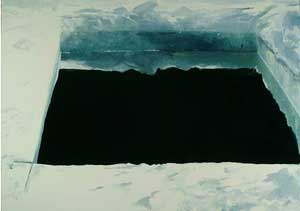
Ice Cut 2008 oil on linen 50 x 70 inches
LG:
You had some sort of personal connection to the ice harvesting with your family, as I recall.
Eric Aho:
That’s right. Well, it was pretty common for rural families, in the 19th century, and then up until about World War II, to be involved in ice harvesting. My father grew up in a very large, a very tight Finnish community in Western Massachusetts, and he told us many tales about that life; but most notably, really, is his experience harvesting ice in the winters. It would be cut and then loaded on trains, and sent to Boston, or Worcester, or wherever it ended up going.
In a way I couldn’t have imagined, this became the story that he told just a few hours before he died. He was reliving the scale of events and the experience. You’re talking about the sound of the steam locomotives and the smell of the wet wool and the numb fingers and the Finnish language in the air, and the smell of coffee; and of course, then, the frightening whir of the saw and the cracking of the ice — I mean, things like that created an imprint on this ten-year-old boy, that he carried with him for his entire life.
They were the kind of stories as kids, when we would say, “Oh, gosh, Dad, no, not again. We don’t need to hear that again.” But he was insistent upon it. I think everybody has an uncle or a relative who just can’t stop on a few subjects. But many, many years later, I realized that this was an image that I need to make for myself, since I no longer have that experience, or I don’t have that experience as a person. We have a refrigerator.
Eric Aho:
So I don’t need to cut the ice other than to maintain some connection to what’s not here any more.
When I made that painting, I realized the other paintings I had been making of the big views weren’t very personal, even though I was sitting on this hill: a gorgeous landscape, a hill in New Hampshire, which was my childhood home, looking into Vermont, which is now my adult home, and I would try to imagine that there was some kind of autobiography happening there — but not really — in the end, it just became a beautiful view.
But a painting like this just showed me what I need to start getting at, I think, and I’ve been painting for twenty years. So it was kind of surprising that now, twenty years later, I just feel like I’m getting started, like what we were saying earlier, when we just started the phone call, about we’re just scratching the surface. It’s both really exciting and a little frustrating that after twenty years, I’m just scratching the surface.
But I think George Nick would say the same thing, after painting for close to sixty years.
LG:
Well, there’s always the famous old saw of, on Michelangelo’s deathbed, of crying and moaning that if only he could have painted good enough — he was worried he wasn’t going to get into heaven, or something.
Eric Aho:
[Laughing] Right. I think they have a special elevator for painters who can really paint.
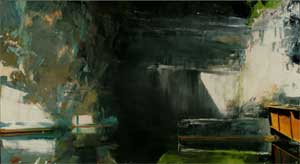
Orange Conveyor 2007 oil on linen 42 x 76 inches
LG:
You received a Fulbright Scholarship which enabled you to paint in Finland, where you have roots. Is your amazing painting, the Black Ice on the North Sea, that’s in your current show, is this from that time there? Can you talk more about what it was like to be there, in Finland, painting? Or that whole experience?
Eric Aho:
That Fulbright year led into, oh, fifteen subsequent years of painting and traveling to Finland to paint, to exhibit; to teach, and conduct a parallel life over there for a good many years, which I don’t do, quite as much now, with my two kids and family and work keeping me here. It’s been a year-and-a-half, two years, now, since I’ve been over.
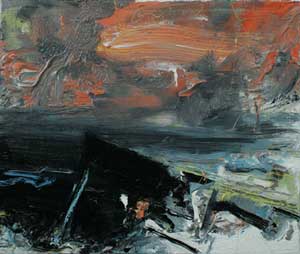
Black Ice on the North Sea no. 3 2009 Oil on linen, 10 x 12 inches
The painting you’re asking about here, the Black Ice on the North Sea, is painted in my studio, and it is part of a group of paintings that are really about memories of the furthest, remotest places I’ve ever traveled to, as a way to satisfy my wanderlust, which I’m not able to really, like I said, participate in right now.
So I can go to the studio, and I can imagine and remember the ice, shearing up in front of me on a spectacularly, cold day — not a snow-covered landscape, but rather an ice-covered landscape in that kind of black January there. The areas around the North Sea and the Baltic don’t get much snow, but they get bitterly cold, and when the wind whips up, the ice freezes on the rocks, and just starts shearing up, and really over the course of an hour, an entirely new sort of landscape can form.
I didn’t paint that particular experience. I just happened to be walking along the coast, at that point, but it’s something that stuck with me, and there it turns up in a painting, and a series of little paintings — there are three little paintings in succession that follow the building of the ice along the coast.
They have little bits of Caspar David Friedrich and Emil Nolde mixed into that memory. We all carry these paintings around in our heads that are crucial to us, and once in a while, they really become part of the mix, not in any kind of homage, or in any kind of reference, but they just really become part of it, the attitude or the momentum of that painting continue to infuse itself in the current work.
So that specific painting was really about transporting myself back to some other place. I’ve made a real point, over fifteen years or so, of traveling exhaustively around Scandinavia. I’ve traveled most of the Norwegian Arctic coastline into Western Russian Siberia, and pretty much throughout all of Finland; I mean, these little remote villages that even the Finns don’t bother going to, I find the remote fascinating.
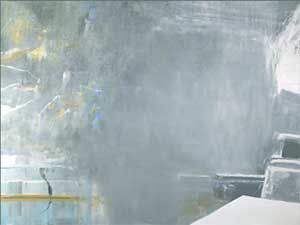
Quarry Seen as an Iceberg 2007 oil on linen 62 x 80 inches
There’s a great culture of landscape painting throughout Scandinavia, and in particular, Finland, growing out of the 19th century and that search for national identities, which a number of countries in Northern Europe and also then, a little bit later, the United States after the Civil War, found that they relied on the landscape to help create a kind of collective consciousness among its people, from Frederick Church and Albert Bierdstadt — well, starting with Thomas Cole, this group of painters in America give us the ideas of the landscape, and in many ways, the way we see America today, come from some of those artists.
And so, it’s still very vital and very much alive, and it’s exciting to be — it’s similar to something of an outpost, too. It’s not like sitting on a hill in Italy that has been painted for centuries by artists of great reputation. It’s relatively unknown and not really cared about. So, there’s a little bit of freedom in that.
But specifically, it’s my cultural heritage, and there’s again something personal in that, that I find some way of connecting.
Audio Podcast of interview (approx. 1 hour) – right click to save to hard drive
[podcast]http://eric-aho-interview.s3.amazonaws.com/ericaho.mp3[/podcast]
Interview with Eric Aho – Part One
Interview with Eric Aho – Part Three





Leave a Reply